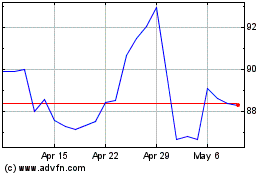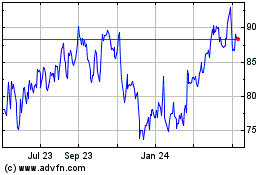Permian Resources Draws Strong Interest From Debt Investors
July 12 2016 - 1:40PM
Dow Jones News
Wall Street debt investors have encircled a beleaguered oil
producer founded by the late Aubrey McClendon and are in early
talks to take control of it in a deal that could also take the
company public, according to people familiar with the matter.
Such a deal, for Permian Resources LLC, w ould come in a hot
market for shares of companies that drill in the Permian Basin
region of West Texas and potentially head off a more contentious
restructuring of the company, which credit-rating firms have said
is likely to run out of cash by early next year barring a big rise
in oil prices.
Among the firms that have gobbled up Permian Resources'
discounted debt are Apollo Global Management LLC, Oaktree Capital
Group LP, EIG Global Energy Partners, Ares Management LP and WL
Ross & Co., the people said.
They are in talks with Permian Resources' owners, which include
energy-focused private-equity firms Energy & Minerals Group and
First Reserve Corp. as well as the estate of Mr. McClendon, t he
energy titan who died in an early March car wreck in Oklahoma
City.
The talks are nascent, the people cautioned, and may not lead to
a deal.
A deal for Permian Resources would represent one of the first
instances in the current commodities bust in which creditors gained
control of a significant oil and gas producer. The talks also come
as creditors tussle in Oklahoma City probate court over the web of
assets and liabilities that Mr. McClendon left behind.
Among the possibilities discussed for Permian Resources, the
people said, are swapping debt for equity and pursuing a public
listing through a merger, potentially with a blank-check company,
entities without assets that sell shares to raise cash for future
acquisitions. A deal could also include an cash infusion from the
company's current owners, creditors or someone else, they said.
The biggest oil bust in decades has made buying debt of
distressed energy companies popular with big investors. Such
situations often play out in one of two ways. If the indebted
company rebounds, its bond prices rise. If it fails, the debt
holder often has a claim on the company's assets.
So far, though, many companies have staved off serious
entanglements with creditors by selling assets and new shares to
raise cash.
Most of the more than 80 North American energy producers that
have filed for bankruptcy since 2014 didn't have the prime drilling
fields that Permian Resources owns, making it difficult for them to
raise cash and making them less attractive to investors maneuvering
to take over assets.
Mr. McClendon launched Permian Resources in 2014 after he was
ousted from Chesapeake Energy Corp., the oil and gas giant he
co-founded. Originally called American Energy-Permian Basin LLC, it
was one of several oil and gas ventures the oilman started with
Houston private investment firm Energy & Minerals Group.
EMG, which is led by John Raymond, the son of former Exxon Mobil
Corp. chief Lee Raymond, and other investors bet big on Mr.
McClendon's comeback, backing several new energy companies,
including Permian Resources. Fueled by more than $15 billion of
cash and debt raised from his backers, Mr. McClendon quickly got to
work buying up swaths of drilling land around the country.
Permian Resources spent more than $3.6 billion acquiring
properties in West Texas before oil prices plunged in late 2014,
mostly with borrowed money, according to its public
disclosures.
Though the company has nearly tripled its production, to the
equivalent of about 28,000 barrels a day, oil's fall to about the
half the $100 a barrel range at which it traded when Permian
Resources got started has crimped the firm. It has restructured
some debt, though it had to agree to a higher interest rate to do
so, and said it bought back more than $200 million of bonds for 10
cents on the dollar earlier this year.
"Despite the debt reduction, we continue to view Permian
Resources' leverage as unsustainable, and believe the company could
face a liquidity shortfall next year, absent additional asset sales
or an equity infusion," S&P Global Ratings analyst Carin
Dehne-Kiley said in a May report.
Permian Resources carries about $2.4 billion of debt, some of
which has recently traded at about 55 cents on the dollar,
according to FactSet.
Fire-sale prices like that have enabled Wall Street firms to
stake claim to drilling fields in the country's most prolific
drilling region on the cheap. Stacked layers of energy-bearing rock
help many Permian Basin wells produce oil in enough volume to make
drilling worth the expense, even amid low crude prices.
EIG last year told investors that it had spent roughly $150
million buying Permian Resources' bonds at about 70% of their face
value and had earmarked about $250 million more to keep buying
them, according to documents from the Alaska Retirement Management
Board, which invests with the firm.
(END) Dow Jones Newswires
July 12, 2016 13:25 ET (17:25 GMT)
Copyright (c) 2016 Dow Jones & Company, Inc.
Chesapeake Energy (NASDAQ:CHK)
Historical Stock Chart
From Mar 2024 to Apr 2024

Chesapeake Energy (NASDAQ:CHK)
Historical Stock Chart
From Apr 2023 to Apr 2024
